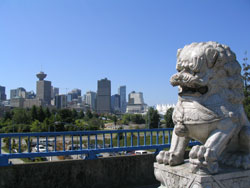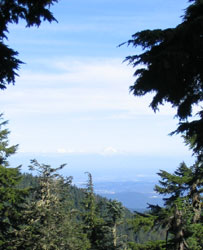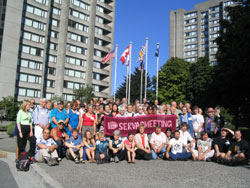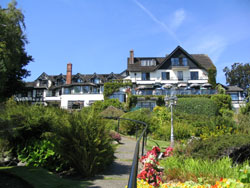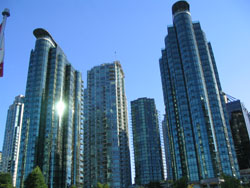We then headed off in small, inconspicuous groups of 3 or 4 people, with a small unobtrusive map. The map pointed out local sights such as buildings, housing coops, community centres, churches and parks. The first thing we did was we headed north out to the bridge at the top of Main Street from where you have a gorgeous view of downtown Vancouver, including Canada Place. It strikes you as ironic, how so much beauty and opulence can be located right next to an area with immense economic and social problems.
We headed west on Alexander Street and promptly arrived on a beautiful little square that is part of Vancouver’s historic restored Gastown area. From there we headed south along streets like Pender and Carrall, many of which have boarded up main floors, and former retail areas that were closed a long time ago. Occasionally you see local homeless people and at one building we saw two young people on a couch in front of a building, and beside them a young woman who was stretching and contorting her body in strange ways. We were later explained that this woman was probably coming down from taking drugs the night before and was experiencing excruciating pain in the process.
We snaked our way through the neighbourhood past various parks that according to our guide book were described as gathering spots for drug activity during the night. Most of these areas were fairly empty, but we did pass a number of people whose appearances had been ravaged by years of drug use. On Pender Street we passed by an astounding building, the Sun Tower, built in 1912, that housed the offices of The Vancouver Sun newspaper from 1924 to1964 and is crowned by a by a three-story beaux arts copper roof.
Pender Street took us further east towards Vancouver’s Chinatown, which compared to the chaotic hustle and bustle of Toronto’s Chinatown, seemed very orderly and organized. Our map told us to make a brief detour into the Dr. Sun Yat-Sen Classical Chinese Garden, opened in 1986, the first full-size authentic Chinese garden built outside of China. From there we went through a mixed neighbourhood with a variety of Chinese or Korean community centres and seniors residences. We also passed by a community centre that offered free showers, Internet access, mailbox and various other services to many of the homeless people in this area. Many of the local churches provide shelter and other services to this community in need.

The gates to Chinatown
One particularly haunting image for me was a very young woman, maybe in her late teens, early twenties. She had bleached blond hair, blue eyes and dark rims of smeared mascara under her eyes. She was leaning into the recesses of a building and had obviously been crying. Something was in her hand, but I was unable to see what it was. She appeared to be in a great deal of physical and emotional pain, and her face was still so young and pristine. I thought how powerfully addictions affect people and how difficult it must be to extricate oneself from this way of life.
My two walking partners commented on another older woman, whose face had been scarred and they commented that the blank look in her eyes was a very haunting experience. Since I was in charge of figuring out the map I did not see this individual, but the ravages of drug use were plainly obvious in so many of the residents’ faces. Ironically enough, as we were looking at our map, we were asked twice by different people if we were lost and if they could help redirect us. We had been prepared for being accosted and asked for money, and instead we were offered some help by the locals – ironic indeed.
After we completed our walk we headed back to the UBC Learning Exchange for a debriefing and we shared our experiences. We noted that the neighbourhood was much more mixed and less consistently run down than we had expected. A comment was also made that relatively few people were on the streets and that we didn’t witness any drug-related or sex-trade transactions at this time of day. Overall it had felt quite safe for us 3 women to walk through this neighbourhood, and during morning hours this area didn’t look all that different from other urban neighbourhoods.

The Carnegie Community Centre
Our learning experience was capped off by a visit at the Carnegie Community Centre, built in 1908 as a Public Library. The Carnegie Centre provides a range of social, recreational and educational programs for the residents of Vancouver’s Downtown Eastside. It is often described as the community’s living room—a place where people can come to participate in programs or to simply relax and socialize with others, particularly important since many of them live in one-room dwellings where they don’t have the luxury of a living room to relax in.
The Carnegie Centre offers a variety of facilities: a Public Library reading room, a seniors centre, weight room, a learning/literacy centre, a kitchen that offers 3 nutritional meals a day, an art gallery, an auditorium and gym as well as a dark room and pottery room. Our group did indeed sample the Carnegie’s cuisine, and I had a vegetarian lunch with veggie spring rolls, salad and rice, as well as one of the most delicious mushroom soups I have ever eaten. Together with a lemon pop this lunch came to $3.40.
The meal was delicious and completing this learning experience in Vancouver’s Downtown East Side truly enriched my understanding of the city and this neighbourhood, and I gained a real appreciation for the efforts of the many hundreds of people who try to bring about positive change in this area. Francy indeed summarized it succinctly: the best way to make a difference is through individual engagement, and the small efforts of many can bring about huge change to the community as a whole.
